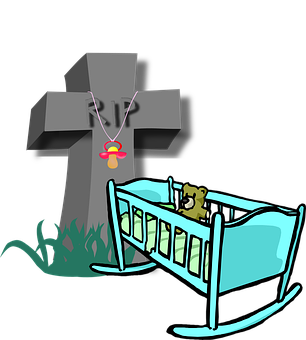Sudden infant death syndrome is defined as the sudden and unexpected death of a child under one year of age. The autopsy does not reveal an explainable cause of death. It is a death very feared by the parents, since it does not present symptoms, warnings or has a clear explanation.


But although the cause of the sudden death of the infant is unknown, at present, many doctors and researchers believe that there are many factors involved, which we comment.
For example, the undeveloped ability of the baby to wake up, as well as the inability of the child's body to detect accumulation of carbon dioxide in the blood. SIDS could originate as a failure in the micro-awakening when there is an episode of prolonged apnea, bradycardia or hypotension, arrhythmias or external situations that can lead to suffocation, that is, there is no response to a life-threatening stimulus during sleep. .
This happens especially between two and four months, when the risk of sudden infant death is higher. SIDS is infrequent during the first month of life, after four months it decreases and after 12 months it is considered that the risk has practically disappeared (then, it is referred to as "sudden death of the child").
It is also known that this syndrome happens more to children than to girls and more cases occur in winter. However, there is no "warning" of any kind: in sudden infant death the baby falls asleep normally and death occurs during sleep.
Before moving on to the factors involved, we left the definition of "sudden infant death" that I found in a study published a year ago in 'Pediatrics' about this concept, defined for the first time in 1969:
Sudden death of a child less than one year of age, which apparently occurs during sleep and remains unexplained after a thorough postmortem investigation, including the practice of autopsy, examination of the place of death and review of the clinical history.

Factors related to sudden death

Image source credit: Pixabay.com
There are some factors that could be involved in the increased risk of sudden death, although the importance of each is unknown and research is continuing on the causes. These are some of the factors:
Sleeping on your stomach. That is why, since parents are advised to put their babies to sleep on their back or side, the cases of sudden infant death syndrome have diminished in the world. It is estimated that in the industrialized countries, the incidence of SIDS has decreased below 1/1000 newborns.
Being in an environment with cigarette smoke while in the womb or after birth. It is estimated that the risk of sudden infant death syndrome in smoking mothers during pregnancy is three times higher than that of nonsmokers. This could explain the importance of the presence of carbon dioxide in the blood in relation to the problem.
Las superficies blandas de camas, cunas, sofás...
Mothers who smoke or consume psychoactive substances (alcohol, drugs, psychodepressants ...) that affect the central nervous system.
The major risk factors for SIDS diminish micro-arousals (prone prone position, maternal smoking, covered head, apneas, hyperthermin).

According to the Medical Library of the United States, the following points would also be related to sudden infant death:
✔Multiple births (being a twin, triplet, etc.).
✔Premature births.
✔Have a brother or sister who suffered SIDS.
✔Being born of a teenage mother.
✔Short time intervals between pregnancies.
✔Late prenatal care or absence of it.
✔Live in conditions of poverty.
✔Sleeping in the same bed with their parents (sleeping accompanied).
The Initiative for the Humanization of Birth Assistance and Breastfeeding recently made a statement indicating that studies have concluded, after an exhaustive review on co-sleeping, lactation and sudden infant death, that co-sleeping is a beneficial practice for breastfeeding . And, in short, that well-practiced co-sleeping, avoiding risk factors, would not be related to the sudden death of the infant.
However, pediatric associations and organizations recommend avoiding co-sleeping by relating it to sudden infant death and instead practicing "cohabitation", that is, sleeping in the same room as the baby, being in a crib or crib. to the parents' bed.

Reduce the risk of sudden infant death
The American Academy of Pediatrics recommends the following to reduce the risk of sudden infant death syndrome:
Always put the baby to sleep on his back (even during naps). Do not put a baby to sleep on his stomach during the first year of life. However, if your baby has turned and has been put on his side or upside down by himself, you can leave him in that position if he can already turn from face down to face up and vice versa. If your baby falls asleep in a car safety seat, a stroller, a swing, a baby carrier or a pouf must pass it to a firm surface as soon as possible.
Put the babies to sleep on a firm surface (such as a crib). Cradle, bassinet, strollers ... must comply with current safety standards, not be old products removed from the market ... And of course not use broken, defective or incomplete cradles.
Cover the firm mattress with a fitted sheet. Do not place blankets or pillows between the mattress and the fitted sheet. Never put the baby to sleep in a chair, a sofa (considered a dangerous place for a baby to sleep), a water bed, a cushion, or a sheep skin blanket.
Keep soft objects, loose bedding or any other object that may increase the risk of the baby being trapped, suffocated or strangled out of the crib. Pillows, quilts, quilts, fur blankets, cushions and stuffed toys can make your baby choke. Most experts agree that after twelve months of life, these objects imply a low risk for healthy babies, although there are no conclusive studies in this regard.
It is recommended to put the baby to sleep in the same room in which the parents sleep, but not in the same bed. Keep the crib or bassinet close to the bed, so that the baby can be reached easily: this way you can easily observe or breastfeed your baby if you are near him.

[Image Source credit: Pixabay.com CC3.0 license. Author: unknown]
In general, do not use products that claim to reduce the risk of SIDS (subject to babies, positioners, special mattresses and special sleeping surfaces ...) since they have not been shown to reduce the risk. Also, some babies have suffocated while using these products.
We hope that with this review on what is the sudden death of the infant and the tips to reduce the risk will be useful and you spend the nights in family more calm and safe.
Keep the baby away from smokers and the places where people smoke. You have to try to smoke and until you can, keep the car and home smoke free. Nor should you smoke near the baby, even if it is outdoors.
I hope you liked this little research, and it will be until next time we see each other, you are writing me at wahtsapp.
References:
Book
®✔Álvaro Enrigue (tr. Natasha Wimmer). (2016). Sudden Death. Riverhead: Best Books, Inc.
®✔All images have the proper permission for their publication and each one has its source.
Important notice for your steemstem post:
If you write STEM (Science, Technology, Engineering, and Mathematics) related posts, consider joining #steemSTEM on steemit chat or discord here. If you are from Nigeria, you may want to include the #stemng tag in your post. You can visit this blog by @stemng for more details. You can also check this blog post by @steemstem here and this guidelines here for help on how to be a member of @steemstemproper use of images devoid of copyright issues here.. Please also check this blog post from @steemstem on


|| @ocd || @anomadsoul || @acidyo || @ocd-resteem || @utopian-io || @vortac || @cervantes || @hendrikdegrote || ¡Vote for witness! Here: https://steemit.com/~witnesses

Good common sense evidence based suggestions for decreasing SIDS. The only reason millions of people worldwide are not still dying from smallpox and being in iron lungs is because our parents and grandparents made sure we received these vaccines. The world is now free from smallpox and the vaccine is no longer necessary because the disease was eliminated by the vaccine. My friend in second grade was in an iron lung from polio. Luckily I received the vaccine and did not get polio. The only two remaining countries with polio are India and Pakistan. Once they are clear we can stop giving anyone the polio vaccine. Rare deaths from adverse reactions to vaccines need to be weighed against the thousands of lives they save. In 1952 there were 58,000 US cases of polio and 3,000 US deaths from polio.Since 2000 we have had no cases of polio except those brought in from other countries (and no deaths). In 1952 there 700,000 cases of US measles and over 600 US deaths from measles. In 2016 (after the MMR vaccine) there were only 85 cases of US measles and no deaths. Risk vs. benefit is strongly in favor of vaccines.
Many SIDS cases are the result of adverse reactions to vaccines. This is obviously denied by the powers-that-shouldn't-be
It is not always so but in some isolated cases these cases have been seen ... and your vote where is it?
Because some vaccines are given at the same peak age of SIDS (1-6 months) we were concerned if the vaccines might be increasing the risk of SIDS. Studies have shown that not only was there no increase but vaccines actually decreased the SIDS rate. Is the person standing outside the bank being robbed a "lookout" or an innocent bystander that does not even know the bank is being robbed? That is the question science has to answer.
http://www.nationalacademies.org/hmd/Reports/2003/Immunization-Safety-Review-Vaccinations-and-Sudden-Unexpected-Death-in-Infancy.aspx